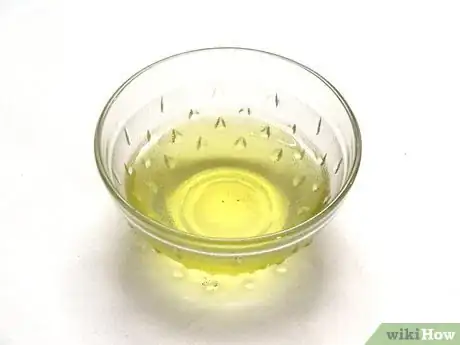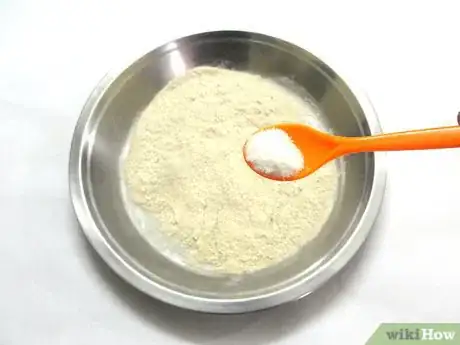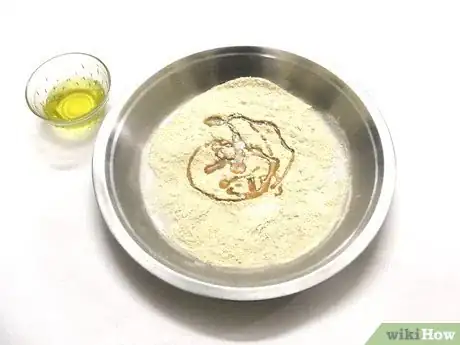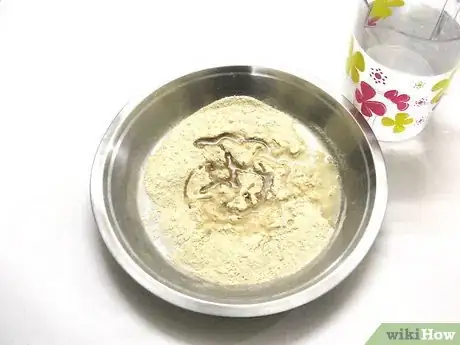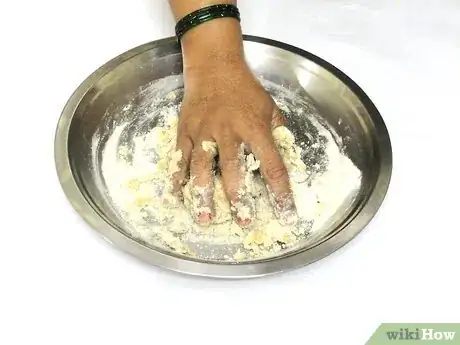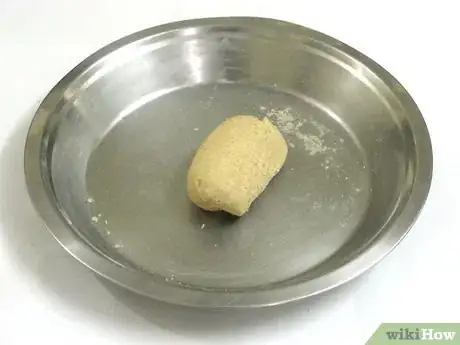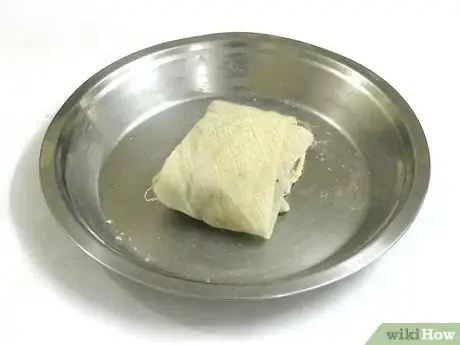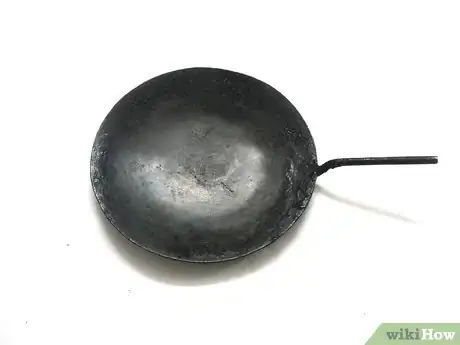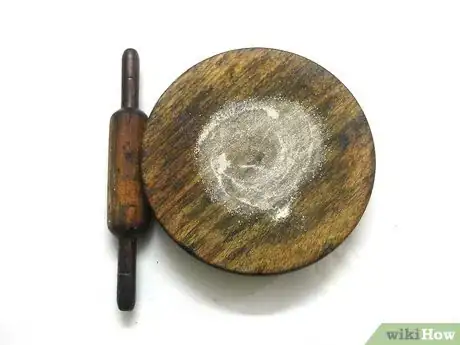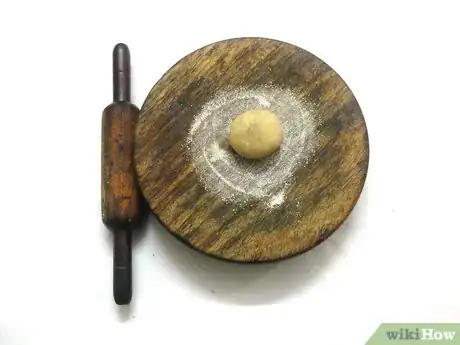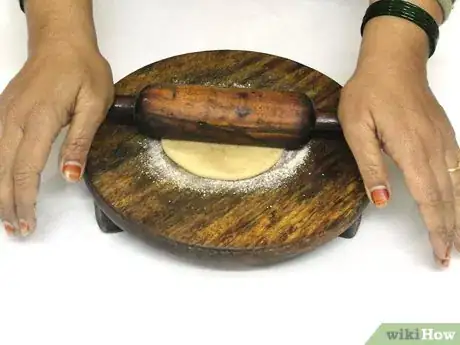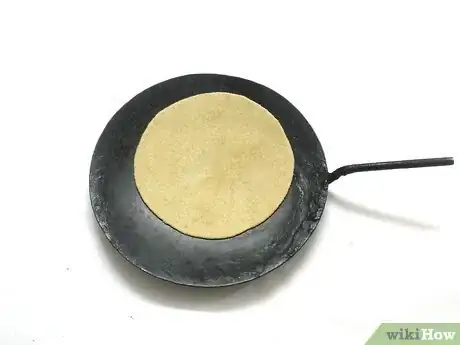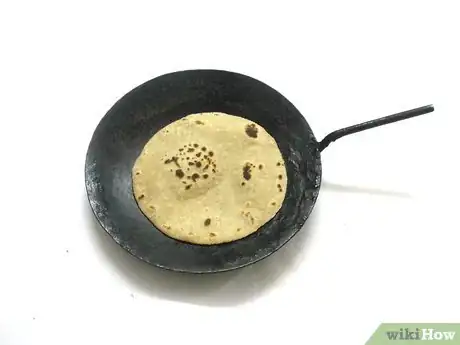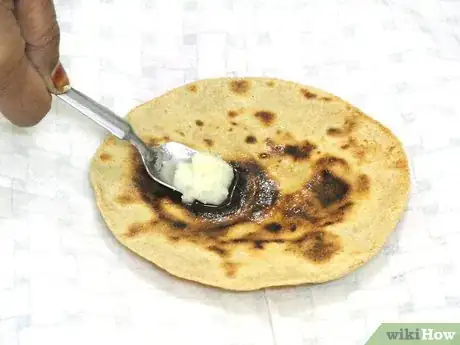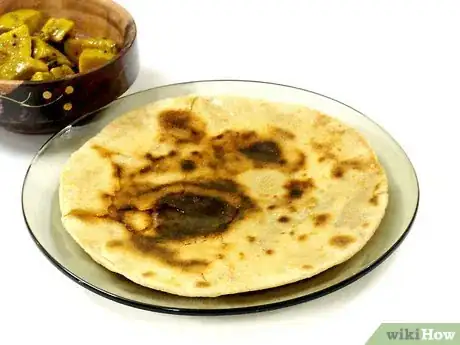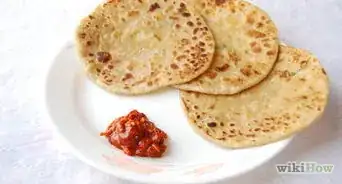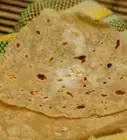This article was co-authored by wikiHow Staff. Our trained team of editors and researchers validate articles for accuracy and comprehensiveness. wikiHow's Content Management Team carefully monitors the work from our editorial staff to ensure that each article is backed by trusted research and meets our high quality standards.
wikiHow marks an article as reader-approved once it receives enough positive feedback. This article received 19 testimonials and 84% of readers who voted found it helpful, earning it our reader-approved status.
This article has been viewed 1,065,770 times.
Learn more...
Roti is a round, flat, unleavened Indian bread. While most Indian restaurants serve naan (a leavened flatbread made with a yeast starter and white flour which is typically cooked in a tandoor oven[1] ), roti is typically made with wheat flour and cooked on a hot griddle.[2] It's an everyday bread that's made fresh and eaten with curries, chutneys, and various other Indian dishes. Indeed, roti is often used as a utensil to scoop up other food. It's a delicious, versatile, and surprisingly easy-to-make bread you can bake at home yourself. This recipe will make 20-30 rotis.
Ingredients
- 3 cups chapatti flour (also known as durum wheat atta) OR 1½ cups whole wheat flour + 1½ cups all-purpose flour
- ½-1 teaspoon salt (optional)
- 1 tablespoon ghee or oil
- 1-1½ cups warm water
Steps
Preparing the Roti Dough
-
1Choose your flour. Traditional roti recipes call for chapati (sometimes spelled “chapatti”) flour, which is also known as durum wheat atta. Some recipes just list “atta” in the ingredients list; they are typically referring to chapati flour (indeed, the terms “roti” and “chapati” are sometimes used interchangeably—they are both unleavened wheat flatbreads).
- Atta/chapati flour is a finely ground whole wheat flour.[3] It's the traditional choice for making roti.
- If you can't find chapati flour or don't have it on hand, you can substitute whole wheat flour. Because it is a heavier flour, though, you should consider using a mixture of half whole wheat flour and half all-purpose flour to more closely approximate the texture of chapati flour.
- You may even use only all-purpose flour in the recipe if that's all you have available. If you go this route, though, you may need to use less water. Be sure to pay attention to the consistency and texture of the dough as you mix; we'll explain more about this in the following steps.
- Additionally, if you use only all-purpose flour, your roti won't have as chewy and nutty of a flavor as traditional roti.
-
2Choose your oil. You'll need to have a small amount of oil on hand to brush the finished rotis with, and optionally, a bit to add to the dough. You can use any cooking oil: olive oil, vegetable oil, melted butter or ghee, but ghee is recommended.
- Ghee is a clarified butter which has been simmered until all of the moisture has evaporated and the milk solids have begun to brown. Ghee has a nutty, carmel-like flavor and color. Ghee has a very high smoke point (almost 375°) and is thus well-suited for frying. It's readily available at Middle-Eastern and Indian markets and specialty food shops, or you can make your own ghee at home.[4]
Advertisement -
3Sift the flour and the salt. Place the flour in a large mixing bowl, your mixer, or the bowl of your food processor (fitted with a dough blade). Add the salt, and mix thoroughly.
-
4Add the ghee (or oil) to the flour. Not all roti recipes call for adding oil to the dough, but doing so can add a bit of flavor to this otherwise simple bread and can also soften it a touch. Add ghee to taste, up to approximately 1 teaspoon. Slowly mix the dough until flakes appear.
- Make sure that your hands are clean if you are mixing the dough by hand. If using a mixer, mix on low speed, or if using a food processor, pulse a few times until you see flakes.
-
5Add the water to the flour. Slowly begin to add lukewarm water to the dough. The dough will be sandy at first, but as you add more, it should start to pull together to form a ball.
- Be sure not to add the water too quickly; you don't want your dough to be too sticky or you won't be able to roll it out.
- If you are using a mixer or a food processor you may have to stop on occasion to scrape down the sides of the bowl before mixing/pulsing more.
- The finished dough should be soft and slightly sticky, though you should be able to peel it off your hand. If it sticks to your hands, it is too wet, and you should add a bit more flour.
-
6Knead the dough. Once your ball of dough has formed, let your mixer or food processor run for another couple of minutes and/or knead by hand for about five minutes. This will help gluten proteins form.
- The amount of time you need to spend kneading the dough is flexible, and depends upon the strength of your kneading or your kitchen appliance. You are aiming at producing a pliable, stretchy dough that you'll be able to roll out.
-
7Let the dough rest. Once you've finished kneading the dough, brush it lightly with oil or ghee, and cover it with a damp paper towel or cloth. Let the dough rest for approximately 30 minutes (it's fine to let it rest longer).
- Letting the dough rest will result in softer rotis. The gluten you formed during the kneading process will relax, and any air bubbles will have a chance to be worked out of the dough.[5]
Cooking your Rotis
-
1Heat up your cooking surface. To cook your rotis, you will need a griddle, a cast-iron skillet with a diameter of at least 8–9 inches (20.3–22.9 cm), or a traditional iron tawa. Place the griddle on medium-high heat.
- You can test the heat of your griddle by dropping a pinch or two of flour on the surface. When the flour browns, you'll know that your cooking surface is hot enough.
- Most roti recipes recommend heating your cooking surface while you are rolling out the dough. If you are new to this, though, the rolling process may take a bit of time, in which case you don't want your griddle to get too hot or start smoking. If that is the case, you can wait to heat up your griddle.
-
2Prepare your rolling surface. You will need a large flat space for rolling the dough. A marble slab or traditional chapati block are ideal choices, but a large wooden cutting board or even a countertop will work. Lightly dust the rolling surface with flour, and keep a small amount (about a ¼ cup) nearby for dusting on your hands as you work with the dough. Powder your rolling pin as well.
-
3Knead and divide the dough. Take the rested dough and knead it for a minute or two until the dough relaxes. Divide the dough into even balls of the same size (approximately 2" in diameter).
-
4Roll out the balls. Take one ball and begin to flatten it between your palms. Lightly dust both sides with flour, and begin to roll out the ball on your powdered surface with your powdered rolling pin.
- Move your rolling pin constantly in order to get as circular of a shape as possible. Envision a clock when you roll: Roll up from six o' clock to twelve o' clock, then up from seven o' clock to one o' clock, etc.
- Be sure to flip the dough circle regularly so that the underside does not stick to the surface, and be sure to sprinkle more flour on the dough and the rolling surface as needed.
- Aim for a circle that is about 6-8" in diameter, but be sure not to roll the dough too thin. If it's too thin, holes will develop or the dough will stick.
-
5Begin cooking the roti. Place your flattened dough on the hot pan or tawa for about 15-30 seconds. The roti will be ready to be flipped when you start to see bubbles form on the top side. Observe the texture on the upside as well: it will begin to appear more dry when the underside is cooked. You can also peek at the underside using a spatula or a pair of tongs: flip it when you see brown spots.
-
6Finish cooking the roti. Cook the other side of the roti for about another 30 seconds. The roti will begin to puff (which is good!), but take a clean, dry towel and gently press the roti, focusing on areas that are puffing (this will help the air pass more evenly through the dough and help it puff more uniformly) and any areas that aren't touching the griddle.
- Don't be afraid to rotate the roti so that it doesn't stick or overcook in any one area. You can also flip it back over to brown up the other side a bit more.
- Depending upon how hot your cooking surface is, you may need to take more or less time in between flips. Pay closer attention to how the roti is browning as opposed to how long it has been cooking.
-
7Remove the roti and repeat with the next ball of dough. Place the finished roti on a clean, dry towel and lightly brush with ghee or oil, then fold the towel over it. This will help keep the roti warm and soft while you continue cooking the remainder of your batch.
-
8Enjoy the product of your labor! For a complete Indian feast, try your hand at making raita, curry, aloo methi, and Tarka Dal. Serve with your freshly-made rotis!
Shopping List and Recipe
Community Q&A
-
QuestionHow do I make soft chapati?
 Community AnswerKnead the soft dough and let it rest for at least 30 minutes before rolling out to cook.
Community AnswerKnead the soft dough and let it rest for at least 30 minutes before rolling out to cook. -
QuestionWhy is there no baking powder in the roti?
 Community AnswerTraditionally roti is only made with flour and water; some people will add a little bit of cooking oil. All other variations with baking powder, baking soda, or yeast are not considered as roti. Instead, they are considered as naan, flat bread, etc.
Community AnswerTraditionally roti is only made with flour and water; some people will add a little bit of cooking oil. All other variations with baking powder, baking soda, or yeast are not considered as roti. Instead, they are considered as naan, flat bread, etc. -
QuestionWill eating roti make me fat?
 Community AnswerEating anything can make you fat if you eat too much of it. Carbs, including roti, can lead to easier weight gain in some individuals when compared with other foods because carbs aren't as satiating as fats or proteins, leading you to consume more than you should.
Community AnswerEating anything can make you fat if you eat too much of it. Carbs, including roti, can lead to easier weight gain in some individuals when compared with other foods because carbs aren't as satiating as fats or proteins, leading you to consume more than you should.
About This Article
To make traditional roti, sift 3 cups (390 g) of chapatti flour. Pour it into a mixing bowl and stir in about 1 tsp (5.7 g) of salt. Add 1 teaspoon (5 mL) of ghee or olive oil and slowly stir it in until the dough forms flakes. Slowly mix in about 1 to 1 ½ cups (237-355 mL) of lukewarm water until you have a soft, slightly sticky ball of dough. Knead the dough by hand for about 5 minutes or mix it with an electric mixer for about 2 minutes until it’s stretchy. Brush the dough with a light layer of oil or ghee and cover it with a damp cloth or paper towel. Let it rest for at least 30 minutes. Heat up an 8-9 inch (20-23 cm) skillet or griddle over medium-high heat until a pinch of flour dropped in the pan browns immediately. Lightly flour a flat surface, like a chapati block, as well as your hands and rolling pin. Knead the dough for a minute and divide it into balls about 2 inches (5 cm) across. Flatten a ball of dough into a squashed circle, dust both sides of it with flour, and roll it out on your floured surface until you have a thin circle that’s about 6-8 inches (15 to 20 cm) across. Put the flattened dough in the pan and cook it for 15-30 seconds, or until brown spots appear on the underside. Flip it and cook the other side for 30 seconds. Put each finished piece of roti on a clean, dry towel and brush it lightly with ghee, then fold the towel over it. If you want to learn what to serve your roti with, keep reading the article!

